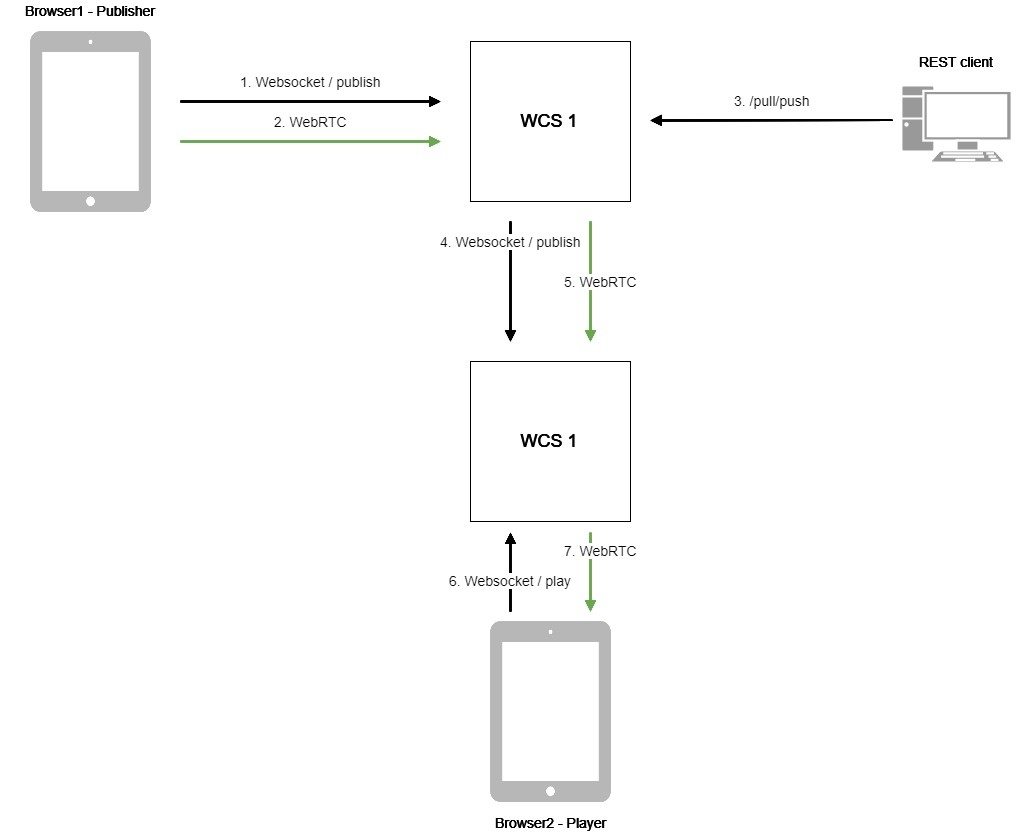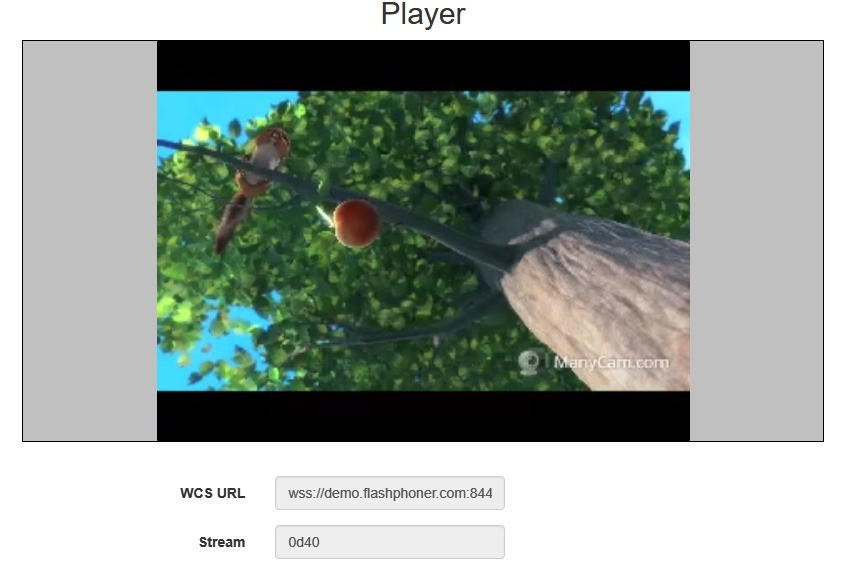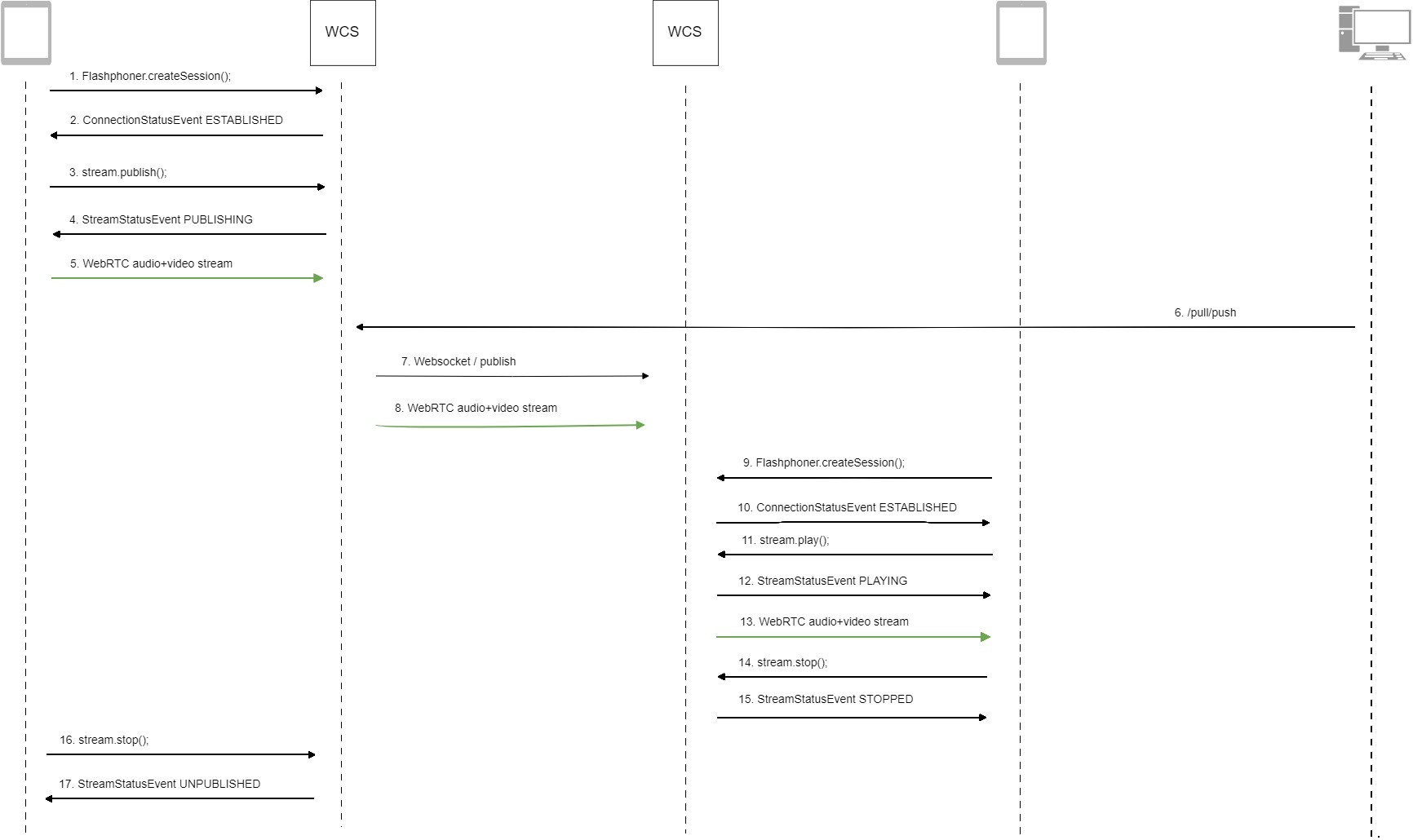| Table of Contents |
|---|
Overview
Upon request WCS can rebroadcast a video stream via WebRTC to another WCS server. Republishing of a WebRTC stream is managed by the REST API.
Operation flowchart
- The browser connects to the WCS1 server via the Websocket protocol and sends the publish command.
- The browser captures the microphone and the camera and send the WebRTC stream to the server.
- The REST client sends to the WCS1 server the /pull/push query.
- WCS1 publishes the stream to WCS2.
- WCS2 receives the WebRTC stream from WCS1.
- The second browser establishes a connection to the WCS2 server via Websocket and sends the play command.
- The second browser receives the WebRTC stream and plays this stream on the page.
REST queries
A REST query must be an HTTP/HTTPS POST query in the following form:
- HTTP: http://test.flashphoner.com:8081/rest-api/pull/push
- HTTPS: https://test.flashphoner.com:8444/rest-api/pull/push
Where:
- streaming.flashphoner.com - is the address of the WCS server
- 8081 - is the standard REST / HTTP port of the WCS server
- 8444 - is the standard HTTPS port
- rest-api - is the required prefix
- /pull/push - is the REST-method used
REST-methods and response statuses
...
REST-method
...
Example of REST query
...
Example of REST response body
...
Response statuses
...
Description
...
/pull/push
...
| Code Block | ||||
|---|---|---|---|---|
| ||||
{
"uri":"wss://demo.flashphoner.com:8443",
"localStreamName": "testStream",
"remoteStreamName": "testStream"
} |
409 - Conflict
500 - Internal error
...
Broadcasts the WebRTC stream at the specified URL
Parameters
...
Parameter name
...
Description
...
Example
...
uri
...
URL of the WebRTC stream
...
wss://demo.flashphoner.com:8443
...
localMediaSessionId
...
Session identifier
...
5a072377-73c1-4caf-abd3
...
remoteMediaSessionId
...
Identifier of the session on the remote server
...
12345678-abcd-dead-beaf
...
localStreamName
...
Local name assigned to the captured stream. The stream can be fetched from the WCS server using this name
...
testStream
...
remoteStreamName
...
Name of the captured stream on the remore server
...
testStream
...
status
...
Current status of the stream
...
NEW
Quick manual on testing
1. For this test we use:
- two WCS servers;
- the Chrome browser and the REST client to send queries to the server;
- the Two Way Streaming web application to publish the stream;
- the Player web application to play the captured stream in a browser.
2. Open the Two Way Streaming web application, publish the stream on the server
3. Open the REST client. Send the /pull/push query and specify in its parameters:
- the URL of the WCS server the stream is captured from;
- the name of the stream published on the server
- the localname of the stream
4. Open the Player web application and specify the local stream name in the Stream field, then click Start
Call flow
Below is the call flow when using the Two Way Streaming example to publish a stream on one WCS server and the Player example to play that stream on another WCS server.
...
Flashphoner.createSession(); code
| Code Block | ||||
|---|---|---|---|---|
| ||||
Flashphoner.createSession({urlServer: url}).on(SESSION_STATUS.ESTABLISHED, function (session) {
setStatus("#connectStatus", session.status());
onConnected(session);
}).on(SESSION_STATUS.DISCONNECTED, function () {
setStatus("#connectStatus", SESSION_STATUS.DISCONNECTED);
onDisconnected();
}).on(SESSION_STATUS.FAILED, function () {
setStatus("#connectStatus", SESSION_STATUS.FAILED);
onDisconnected();
}); |
2. Receiving from the server an event confirming successful connection.
ConnectionStatusEvent ESTABLISHED code
| Code Block | ||||
|---|---|---|---|---|
| ||||
Flashphoner.createSession({urlServer: url}).on(SESSION_STATUS.ESTABLISHED, function (session) {
setStatus("#connectStatus", session.status());
onConnected(session);
}).on(SESSION_STATUS.DISCONNECTED, function () {
...
}).on(SESSION_STATUS.FAILED, function () {
...
}); |
...
stream.publish(); code
| Code Block | ||||
|---|---|---|---|---|
| ||||
session.createStream({
name: streamName,
display: localVideo,
cacheLocalResources: true,
receiveVideo: false,
receiveAudio: false
...
}).publish(); |
...
StreamStatusEvent, status PUBLISHING code
| Code Block | ||||
|---|---|---|---|---|
| ||||
session.createStream({
name: streamName,
display: localVideo,
cacheLocalResources: true,
receiveVideo: false,
receiveAudio: false
}).on(STREAM_STATUS.PUBLISHING, function (stream) {
setStatus("#publishStatus", STREAM_STATUS.PUBLISHING);
onPublishing(stream);
}).on(STREAM_STATUS.UNPUBLISHED, function () {
...
}).on(STREAM_STATUS.FAILED, function () {
...
}).publish(); |
...
6. Sending the /pull/push REST query to the server
7. Publishing the stream on the second server
8. Sending the audio-video stream via WebRTC to the second server
9. Establishing a connection to the second server.
Flashphoner.createSession(); code
| Code Block | ||||
|---|---|---|---|---|
| ||||
Flashphoner.createSession({urlServer: url}).on(SESSION_STATUS.ESTABLISHED, function(session){
setStatus(session.status());
//session connected, start playback
playStream(session);
}).on(SESSION_STATUS.DISCONNECTED, function(){
setStatus(SESSION_STATUS.DISCONNECTED);
onStopped();
}).on(SESSION_STATUS.FAILED, function(){
setStatus(SESSION_STATUS.FAILED);
onStopped();
}); |
10. Receiving from the server an event confirming successful connection.
ConnectionStatusEvent ESTABLISHED code
| Code Block | ||||
|---|---|---|---|---|
| ||||
Flashphoner.createSession({urlServer: url}).on(SESSION_STATUS.ESTABLISHED, function(session){
setStatus(session.status());
//session connected, start playback
playStream(session);
}).on(SESSION_STATUS.DISCONNECTED, function(){
...
}).on(SESSION_STATUS.FAILED, function(){
...
}); |
...
stream.play(); code
| Code Block | ||||
|---|---|---|---|---|
| ||||
stream = session.createStream(options).on(STREAM_STATUS.PENDING, function(stream) {
...
});
stream.play(); |
12. Receiving from the server an event that confirms successful capturing and playing of the stream.
StreamStatusEvent, status PLAYING code
| Code Block | ||||
|---|---|---|---|---|
| ||||
stream = session.createStream(options).on(STREAM_STATUS.PENDING, function(stream) {
...
}).on(STREAM_STATUS.PLAYING, function(stream) {
$("#preloader").show();
setStatus(stream.status());
onStarted(stream);
}).on(STREAM_STATUS.STOPPED, function() {
...
}).on(STREAM_STATUS.FAILED, function(stream) {
...
}).on(STREAM_STATUS.NOT_ENOUGH_BANDWIDTH, function(stream){
...
});
stream.play(); |
13. Sending the audio-video stream via WebRTC
14. Stopping the playback of the stream.
stream.stop(); code
| Code Block | ||||
|---|---|---|---|---|
| ||||
function onStarted(stream) {
$("#playBtn").text("Stop").off('click').click(function(){
$(this).prop('disabled', true);
stream.stop();
}).prop('disabled', false);
...
} |
15. Receiving from the server an event confirming the playback of the stream is stopped.
StreamStatusEvent, status STOPPED code
| Code Block | ||||
|---|---|---|---|---|
| ||||
stream = session.createStream(options).on(STREAM_STATUS.PENDING, function(stream) {
...
}).on(STREAM_STATUS.PLAYING, function(stream) {
...
}).on(STREAM_STATUS.STOPPED, function() {
setStatus(STREAM_STATUS.STOPPED);
onStopped();
}).on(STREAM_STATUS.FAILED, function(stream) {
...
}).on(STREAM_STATUS.NOT_ENOUGH_BANDWIDTH, function(stream){
...
});
stream.play(); |
16. Stopping publishing the stream.
stream.stop(); code
| Code Block | ||||
|---|---|---|---|---|
| ||||
function onPublishing(stream) {
$("#publishBtn").text("Stop").off('click').click(function () {
$(this).prop('disabled', true);
stream.stop();
}).prop('disabled', false);
$("#publishInfo").text("");
} |
17. Receiving from the server an event that confirms unpublishing of the stream.
StreamStatusEvent, status UNPUBLISHED code
...
| language | js |
|---|---|
| theme | RDark |
...
| Include Page | ||||
|---|---|---|---|---|
|




